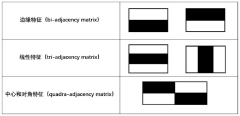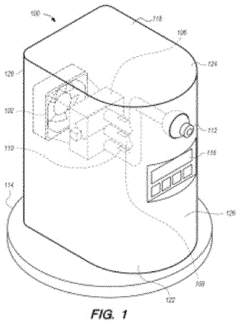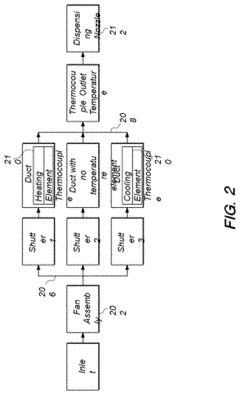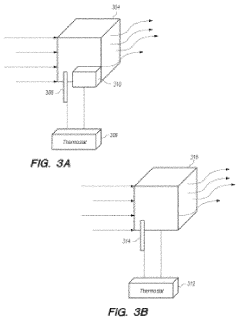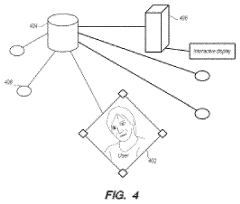How to Transform Learning Environments with ULED?
JUN 20, 20259 MIN READ
Generate Your Research Report Instantly with AI Agent
Patsnap Eureka helps you evaluate technical feasibility & market potential.
ULED in Education: Background and Objectives
Ultra-Light Emitting Diode (ULED) technology has emerged as a groundbreaking innovation in the field of education, promising to revolutionize learning environments. The evolution of educational technology has been marked by continuous efforts to enhance the quality of visual displays, improve energy efficiency, and create more immersive learning experiences. ULED represents the latest advancement in this journey, building upon the foundations laid by earlier technologies such as CRT, LCD, and LED displays.
The primary objective of integrating ULED technology into educational settings is to transform traditional classrooms into dynamic, interactive spaces that cater to diverse learning styles and pedagogical approaches. By leveraging the unique properties of ULED, educators aim to create more engaging, flexible, and personalized learning environments that can adapt to the evolving needs of students and teachers alike.
ULED technology offers several key advantages that make it particularly suitable for educational applications. Its ultra-thin and lightweight design allows for easy installation and integration into various classroom settings, from small study areas to large lecture halls. The superior image quality, characterized by high contrast ratios, wide color gamut, and excellent brightness, ensures that educational content is displayed with exceptional clarity and vibrancy, enhancing student engagement and comprehension.
Moreover, the energy efficiency of ULED technology aligns well with the growing emphasis on sustainability in educational institutions. By consuming significantly less power than traditional display technologies, ULED contributes to reducing the carbon footprint of schools and universities while also lowering operational costs.
The potential applications of ULED in education extend beyond mere display functionality. Its flexibility and scalability open up possibilities for creating interactive walls, smart whiteboards, and immersive learning spaces that blur the lines between physical and digital environments. This convergence of technology and pedagogy has the potential to foster more collaborative, hands-on learning experiences that cater to the needs of 21st-century learners.
As we explore the transformative potential of ULED in education, it is crucial to consider the broader context of technological integration in learning environments. The adoption of ULED technology represents not just a hardware upgrade but a paradigm shift in how we conceptualize and design educational spaces. It challenges educators and administrators to rethink traditional classroom layouts, teaching methodologies, and assessment strategies to fully harness the capabilities of this innovative technology.
The primary objective of integrating ULED technology into educational settings is to transform traditional classrooms into dynamic, interactive spaces that cater to diverse learning styles and pedagogical approaches. By leveraging the unique properties of ULED, educators aim to create more engaging, flexible, and personalized learning environments that can adapt to the evolving needs of students and teachers alike.
ULED technology offers several key advantages that make it particularly suitable for educational applications. Its ultra-thin and lightweight design allows for easy installation and integration into various classroom settings, from small study areas to large lecture halls. The superior image quality, characterized by high contrast ratios, wide color gamut, and excellent brightness, ensures that educational content is displayed with exceptional clarity and vibrancy, enhancing student engagement and comprehension.
Moreover, the energy efficiency of ULED technology aligns well with the growing emphasis on sustainability in educational institutions. By consuming significantly less power than traditional display technologies, ULED contributes to reducing the carbon footprint of schools and universities while also lowering operational costs.
The potential applications of ULED in education extend beyond mere display functionality. Its flexibility and scalability open up possibilities for creating interactive walls, smart whiteboards, and immersive learning spaces that blur the lines between physical and digital environments. This convergence of technology and pedagogy has the potential to foster more collaborative, hands-on learning experiences that cater to the needs of 21st-century learners.
As we explore the transformative potential of ULED in education, it is crucial to consider the broader context of technological integration in learning environments. The adoption of ULED technology represents not just a hardware upgrade but a paradigm shift in how we conceptualize and design educational spaces. It challenges educators and administrators to rethink traditional classroom layouts, teaching methodologies, and assessment strategies to fully harness the capabilities of this innovative technology.
Market Analysis for ULED in Learning Spaces
The market for Ultra-Light Emitting Diode (ULED) technology in learning environments is experiencing significant growth, driven by the increasing demand for innovative and efficient lighting solutions in educational institutions. As schools and universities seek to create more engaging and productive learning spaces, ULED technology offers a compelling solution that combines energy efficiency, superior light quality, and adaptability.
The global education technology market, which includes advanced lighting systems, is projected to reach substantial growth in the coming years. This growth is partly attributed to the integration of smart technologies in classrooms, including ULED lighting systems. The adoption of ULED in learning spaces is expected to accelerate as educational institutions recognize the benefits of improved lighting on student performance and well-being.
One of the key drivers for ULED adoption in learning environments is the growing awareness of the impact of lighting on cognitive function and learning outcomes. Research has shown that proper lighting can enhance concentration, reduce eye strain, and improve overall academic performance. ULED technology, with its ability to mimic natural daylight and adjust color temperature, aligns perfectly with these requirements.
Energy efficiency is another crucial factor driving market growth. Educational institutions are under increasing pressure to reduce their carbon footprint and operational costs. ULED lighting systems consume significantly less energy compared to traditional lighting solutions, offering substantial long-term cost savings and environmental benefits.
The market for ULED in learning spaces is not limited to new construction projects. There is a considerable opportunity in the retrofit market, as existing educational facilities look to upgrade their lighting systems to improve energy efficiency and create more conducive learning environments. This segment is expected to contribute significantly to market growth in the coming years.
Geographically, North America and Europe are currently leading the adoption of ULED technology in educational settings, driven by stringent energy efficiency regulations and a strong focus on creating innovative learning environments. However, the Asia-Pacific region is expected to witness the fastest growth, fueled by rapid urbanization, increasing investment in education infrastructure, and government initiatives promoting smart classrooms.
The competitive landscape of the ULED market for learning spaces is characterized by a mix of established lighting manufacturers and innovative startups. Key players are focusing on developing customized ULED solutions that cater specifically to the unique requirements of educational environments, such as glare reduction, color rendering, and integration with smart building systems.
As the technology matures and economies of scale are achieved, the cost of ULED systems is expected to decrease, further driving adoption in educational institutions across various budget levels. This trend, coupled with the growing recognition of the importance of lighting in learning outcomes, positions ULED technology as a transformative force in shaping the future of learning environments.
The global education technology market, which includes advanced lighting systems, is projected to reach substantial growth in the coming years. This growth is partly attributed to the integration of smart technologies in classrooms, including ULED lighting systems. The adoption of ULED in learning spaces is expected to accelerate as educational institutions recognize the benefits of improved lighting on student performance and well-being.
One of the key drivers for ULED adoption in learning environments is the growing awareness of the impact of lighting on cognitive function and learning outcomes. Research has shown that proper lighting can enhance concentration, reduce eye strain, and improve overall academic performance. ULED technology, with its ability to mimic natural daylight and adjust color temperature, aligns perfectly with these requirements.
Energy efficiency is another crucial factor driving market growth. Educational institutions are under increasing pressure to reduce their carbon footprint and operational costs. ULED lighting systems consume significantly less energy compared to traditional lighting solutions, offering substantial long-term cost savings and environmental benefits.
The market for ULED in learning spaces is not limited to new construction projects. There is a considerable opportunity in the retrofit market, as existing educational facilities look to upgrade their lighting systems to improve energy efficiency and create more conducive learning environments. This segment is expected to contribute significantly to market growth in the coming years.
Geographically, North America and Europe are currently leading the adoption of ULED technology in educational settings, driven by stringent energy efficiency regulations and a strong focus on creating innovative learning environments. However, the Asia-Pacific region is expected to witness the fastest growth, fueled by rapid urbanization, increasing investment in education infrastructure, and government initiatives promoting smart classrooms.
The competitive landscape of the ULED market for learning spaces is characterized by a mix of established lighting manufacturers and innovative startups. Key players are focusing on developing customized ULED solutions that cater specifically to the unique requirements of educational environments, such as glare reduction, color rendering, and integration with smart building systems.
As the technology matures and economies of scale are achieved, the cost of ULED systems is expected to decrease, further driving adoption in educational institutions across various budget levels. This trend, coupled with the growing recognition of the importance of lighting in learning outcomes, positions ULED technology as a transformative force in shaping the future of learning environments.
ULED Technology: Current State and Challenges
Ultra-Light Emitting Diode (ULED) technology has emerged as a promising solution for transforming learning environments, offering significant advancements over traditional lighting systems. The current state of ULED technology showcases impressive capabilities, yet it also faces several challenges that need to be addressed for widespread adoption in educational settings.
ULED technology has made substantial progress in recent years, with improvements in energy efficiency, color rendering, and form factor. Current ULED systems can achieve luminous efficacy of up to 200 lumens per watt, surpassing traditional LED lighting. This high efficiency translates to reduced energy consumption and lower operational costs for educational institutions. Additionally, ULEDs offer superior color rendering capabilities, with Color Rendering Index (CRI) values exceeding 95, providing more natural and vibrant illumination that can enhance visual comfort and potentially improve student focus and well-being.
The miniaturization of ULED components has enabled the development of ultra-thin and flexible lighting panels, allowing for innovative integration into classroom furniture, walls, and ceilings. This flexibility in design opens up new possibilities for creating dynamic and adaptable learning spaces that can be easily reconfigured to suit various educational activities.
Despite these advancements, ULED technology faces several challenges in its application to learning environments. One significant hurdle is the high initial cost of ULED systems compared to conventional lighting solutions. While the long-term energy savings can offset this expense, the upfront investment may be prohibitive for many educational institutions, particularly those with limited budgets.
Another challenge lies in the complexity of ULED control systems. To fully leverage the potential of ULED technology in creating adaptive learning environments, sophisticated control mechanisms are required. These systems need to integrate seamlessly with other classroom technologies and respond to various environmental factors, such as natural light levels and occupancy. Developing user-friendly interfaces that allow educators to easily manage these advanced lighting systems remains a significant technical challenge.
Heat management is another critical issue facing ULED technology. Although ULEDs generate less heat than traditional lighting sources, the compact nature of ULED panels can lead to heat concentration, potentially affecting performance and lifespan. Innovative cooling solutions and thermal management techniques are needed to ensure the long-term reliability of ULED systems in educational settings.
Lastly, the rapid pace of technological advancement in the ULED field presents a challenge for standardization and compatibility. As new ULED products and control systems emerge, ensuring interoperability and future-proofing installations becomes increasingly complex. This lack of standardization may hinder widespread adoption and create difficulties in maintaining and upgrading ULED systems over time.
ULED technology has made substantial progress in recent years, with improvements in energy efficiency, color rendering, and form factor. Current ULED systems can achieve luminous efficacy of up to 200 lumens per watt, surpassing traditional LED lighting. This high efficiency translates to reduced energy consumption and lower operational costs for educational institutions. Additionally, ULEDs offer superior color rendering capabilities, with Color Rendering Index (CRI) values exceeding 95, providing more natural and vibrant illumination that can enhance visual comfort and potentially improve student focus and well-being.
The miniaturization of ULED components has enabled the development of ultra-thin and flexible lighting panels, allowing for innovative integration into classroom furniture, walls, and ceilings. This flexibility in design opens up new possibilities for creating dynamic and adaptable learning spaces that can be easily reconfigured to suit various educational activities.
Despite these advancements, ULED technology faces several challenges in its application to learning environments. One significant hurdle is the high initial cost of ULED systems compared to conventional lighting solutions. While the long-term energy savings can offset this expense, the upfront investment may be prohibitive for many educational institutions, particularly those with limited budgets.
Another challenge lies in the complexity of ULED control systems. To fully leverage the potential of ULED technology in creating adaptive learning environments, sophisticated control mechanisms are required. These systems need to integrate seamlessly with other classroom technologies and respond to various environmental factors, such as natural light levels and occupancy. Developing user-friendly interfaces that allow educators to easily manage these advanced lighting systems remains a significant technical challenge.
Heat management is another critical issue facing ULED technology. Although ULEDs generate less heat than traditional lighting sources, the compact nature of ULED panels can lead to heat concentration, potentially affecting performance and lifespan. Innovative cooling solutions and thermal management techniques are needed to ensure the long-term reliability of ULED systems in educational settings.
Lastly, the rapid pace of technological advancement in the ULED field presents a challenge for standardization and compatibility. As new ULED products and control systems emerge, ensuring interoperability and future-proofing installations becomes increasingly complex. This lack of standardization may hinder widespread adoption and create difficulties in maintaining and upgrading ULED systems over time.
ULED Implementation Strategies for Classrooms
01 ULED display panel structure
ULED (Ultra Light Emitting Diode) display panels feature advanced structures to enhance performance and efficiency. These structures may include specialized pixel arrangements, improved light-emitting layers, and optimized electrode configurations. The design aims to achieve better color reproduction, higher brightness, and increased energy efficiency compared to traditional LED displays.- ULED display panel structure: ULED (Ultra Light Emitting Diode) display panels incorporate advanced structures to enhance performance and efficiency. These structures may include specialized pixel arrangements, improved light-emitting layers, and optimized electrode configurations. The design aims to achieve better color reproduction, higher brightness, and increased energy efficiency compared to traditional LED displays.
- ULED backlight module design: ULED technology is applied in backlight modules for displays, offering improved brightness and uniformity. These modules may feature innovative light guide plates, reflective structures, and optical films to enhance light distribution and reduce power consumption. The design focuses on achieving thinner profiles and better local dimming capabilities for HDR performance.
- ULED driving and control methods: Advanced driving and control methods are developed for ULED displays to optimize performance and reduce power consumption. These may include pulse width modulation techniques, dynamic refresh rate adjustments, and intelligent brightness control algorithms. The methods aim to enhance image quality, reduce motion blur, and extend the lifespan of ULED devices.
- ULED manufacturing processes: Innovative manufacturing processes are employed to produce ULED components and displays. These may include advanced deposition techniques, precise patterning methods, and novel encapsulation processes. The manufacturing focus is on improving yield rates, reducing costs, and enhancing the overall quality and consistency of ULED products.
- ULED application in flexible and transparent displays: ULED technology is adapted for use in flexible and transparent display applications. This involves developing specialized materials, flexible substrates, and novel electrode designs to maintain performance while enabling bending or transparency. The focus is on creating durable, high-quality displays for curved surfaces, wearable devices, and see-through screens.
02 ULED backlight technology
ULED backlight technology incorporates innovative approaches to improve display quality and energy efficiency. This may involve the use of local dimming techniques, advanced light guide plates, and specialized optical films. The technology aims to enhance contrast ratios, reduce power consumption, and provide more uniform illumination across the display surface.Expand Specific Solutions03 ULED color management and image processing
ULED displays employ sophisticated color management and image processing techniques to deliver superior visual quality. This includes advanced algorithms for color calibration, dynamic contrast adjustment, and motion compensation. These technologies work together to provide more accurate color reproduction, enhanced HDR performance, and smoother motion handling.Expand Specific Solutions04 ULED manufacturing processes and materials
The manufacturing of ULED displays involves specialized processes and materials to achieve high performance and reliability. This may include advanced deposition techniques for light-emitting materials, precision patterning methods, and the use of novel substrate materials. These innovations contribute to improved display longevity, enhanced brightness, and better overall display quality.Expand Specific Solutions05 ULED power management and heat dissipation
ULED displays incorporate advanced power management and heat dissipation solutions to optimize performance and extend lifespan. This may involve intelligent power control systems, efficient thermal management designs, and the use of heat-dissipating materials. These features help maintain consistent display performance while minimizing power consumption and preventing heat-related degradation.Expand Specific Solutions
Key Players in ULED and Educational Technology
The transformation of learning environments with ULED technology is in its early stages, with the market showing significant growth potential. The global ULED market is expanding rapidly, driven by increasing demand for high-quality displays in education and other sectors. Technologically, ULED is advancing quickly, with companies like Samsung Electronics, Apple, and Huawei Technologies leading innovation. These firms are developing more efficient, brighter, and cost-effective ULED solutions. Other players such as Lumileds LLC and Xiamen San'an Optoelectronics are contributing to the ecosystem with specialized components and manufacturing processes. The competitive landscape is diverse, with both established tech giants and emerging startups like eLux, Inc. and Micledi Microdisplays BV pushing the boundaries of ULED applications in learning environments.
Samsung Electronics Co., Ltd.
Technical Solution: Samsung has developed advanced ULED (Ultra Light Emitting Diode) technology for transforming learning environments. Their solution integrates high-resolution micro-LED displays with AI-powered content delivery systems. The displays offer superior brightness, contrast, and color accuracy, while consuming less power than traditional LED screens. Samsung's ULED panels can be seamlessly tiled to create large, interactive surfaces for classrooms and lecture halls. The AI system adapts content presentation based on student engagement levels and learning styles, enhancing the overall educational experience.
Strengths: Superior display quality, energy efficiency, and scalability. AI-driven content adaptation enhances learning outcomes. Weaknesses: High initial cost may limit adoption in budget-constrained educational institutions.
Huawei Technologies Co., Ltd.
Technical Solution: Huawei's approach to transforming learning environments with ULED technology focuses on creating immersive and interactive educational spaces. Their solution combines ultra-high definition ULED displays with 5G connectivity and cloud-based learning platforms. The ULED screens offer vivid, lifelike images with wide viewing angles, ideal for large classrooms. Huawei's 5G integration enables real-time collaboration and remote learning capabilities. The cloud-based platform provides access to vast educational resources and supports personalized learning paths. Additionally, Huawei incorporates gesture recognition and voice control features to create intuitive, hands-free interactions with the ULED displays.
Strengths: Comprehensive ecosystem integrating display, connectivity, and cloud technologies. Supports both in-person and remote learning. Weaknesses: Dependence on 5G infrastructure may limit implementation in areas with poor network coverage.
Innovative ULED Applications in Learning
Classroom auxiliary teaching support method based on face recognition and mixed reality
PatentPendingCN118115326A
Innovation
- Using mixed reality technology based on face recognition, the teacher's images are captured in real time through the HoloLens2 device, Opencv and Viola-Jones algorithms are used for face detection, and the data is uploaded to Microsoft Azure's FaceAPI for comparison, combined with Mixed Reality Toolkit and Canvas The learning system enables teachers to view student information in real time on mixed reality devices.
System and Method for an End-User Scripted (EUS) Customized Effect from a Rendered Web-Page
PatentActiveUS20200187324A1
Innovation
- A modularized haptic system that includes a haptic tower with a fan assembly, temperature control, and sensor technology to deliver variable air flow and temperature, integrated with a neural network for learning-based event tracking and prediction, and capable of triggering haptic effects directly from audio/video signals via computer vision processing.
ULED Impact on Student Engagement and Performance
The integration of Ultra-Light Emitting Diode (ULED) technology in learning environments has shown significant potential to enhance student engagement and performance. ULED displays offer superior visual quality, energy efficiency, and flexibility in design, making them ideal for creating dynamic and interactive learning spaces.
Studies have demonstrated that ULED-equipped classrooms can increase student attention spans and improve information retention. The high-quality, flicker-free displays reduce eye strain, allowing students to focus for longer periods without discomfort. This enhanced visual experience has been linked to improved comprehension and recall of presented material.
Interactive ULED displays enable more collaborative learning experiences. Teachers can easily share multimedia content, annotate in real-time, and facilitate group activities. This interactivity promotes active participation and encourages students to engage more deeply with the subject matter. As a result, students demonstrate higher levels of critical thinking and problem-solving skills.
The adaptability of ULED technology allows for personalized learning environments. Adjustable brightness and color temperature settings can be tailored to suit different learning activities and individual student needs. This customization has been shown to positively impact student comfort and focus, leading to improved academic performance.
ULED-based learning spaces also support diverse learning styles. Visual learners benefit from high-resolution graphics and videos, while kinesthetic learners can interact directly with touch-enabled ULED displays. This versatility ensures that a wider range of students can engage effectively with the learning material, potentially reducing achievement gaps.
The implementation of ULED technology in educational settings has been associated with increased student motivation. The modern, technology-rich environment creates a sense of excitement and relevance, encouraging students to take a more active role in their learning. This heightened engagement often translates to improved attendance rates and a more positive attitude towards education.
Furthermore, ULED displays facilitate seamless integration of digital resources and online learning platforms. This blended learning approach allows for more dynamic and up-to-date content delivery, enhancing the overall quality of education. Students can access a wealth of information and interactive tools, fostering independent learning and research skills.
In conclusion, the impact of ULED technology on student engagement and performance is multifaceted and promising. By creating more immersive, interactive, and personalized learning environments, ULED displays have the potential to significantly enhance educational outcomes and prepare students for the digital future.
Studies have demonstrated that ULED-equipped classrooms can increase student attention spans and improve information retention. The high-quality, flicker-free displays reduce eye strain, allowing students to focus for longer periods without discomfort. This enhanced visual experience has been linked to improved comprehension and recall of presented material.
Interactive ULED displays enable more collaborative learning experiences. Teachers can easily share multimedia content, annotate in real-time, and facilitate group activities. This interactivity promotes active participation and encourages students to engage more deeply with the subject matter. As a result, students demonstrate higher levels of critical thinking and problem-solving skills.
The adaptability of ULED technology allows for personalized learning environments. Adjustable brightness and color temperature settings can be tailored to suit different learning activities and individual student needs. This customization has been shown to positively impact student comfort and focus, leading to improved academic performance.
ULED-based learning spaces also support diverse learning styles. Visual learners benefit from high-resolution graphics and videos, while kinesthetic learners can interact directly with touch-enabled ULED displays. This versatility ensures that a wider range of students can engage effectively with the learning material, potentially reducing achievement gaps.
The implementation of ULED technology in educational settings has been associated with increased student motivation. The modern, technology-rich environment creates a sense of excitement and relevance, encouraging students to take a more active role in their learning. This heightened engagement often translates to improved attendance rates and a more positive attitude towards education.
Furthermore, ULED displays facilitate seamless integration of digital resources and online learning platforms. This blended learning approach allows for more dynamic and up-to-date content delivery, enhancing the overall quality of education. Students can access a wealth of information and interactive tools, fostering independent learning and research skills.
In conclusion, the impact of ULED technology on student engagement and performance is multifaceted and promising. By creating more immersive, interactive, and personalized learning environments, ULED displays have the potential to significantly enhance educational outcomes and prepare students for the digital future.
Sustainability and Energy Efficiency of ULED in Schools
The implementation of Ultra-Light Emitting Diode (ULED) technology in schools represents a significant step towards creating more sustainable and energy-efficient learning environments. ULED lighting systems offer numerous advantages over traditional lighting solutions, particularly in terms of energy consumption and environmental impact.
ULED technology consumes significantly less energy compared to conventional lighting systems, resulting in substantial reductions in electricity usage and associated costs. Schools adopting ULED lighting can expect to see a decrease in their energy bills by up to 70%, depending on the specific implementation and usage patterns. This reduction in energy consumption directly translates to a lower carbon footprint, aligning with global efforts to combat climate change and reduce greenhouse gas emissions.
The longevity of ULED lighting systems further contributes to their sustainability profile. With an average lifespan of 50,000 to 100,000 hours, ULED lights far outlast traditional lighting options. This extended lifespan reduces the frequency of replacements, minimizing waste generation and the environmental impact associated with manufacturing and disposing of lighting components.
ULED technology also offers improved light quality and distribution, which can have positive effects on the learning environment. The ability to adjust color temperature and intensity allows for the creation of optimal lighting conditions that support different learning activities and student needs throughout the day. This adaptability can potentially lead to improved student focus, reduced eye strain, and enhanced overall well-being.
From a maintenance perspective, ULED lighting systems require less frequent interventions, reducing the need for ongoing maintenance and replacement costs. This aspect not only contributes to the overall cost-effectiveness of the technology but also minimizes disruptions to the learning environment.
The implementation of ULED technology in schools can serve as an educational tool itself, providing opportunities for students to learn about energy efficiency, sustainability, and cutting-edge technology. This hands-on exposure can foster environmental awareness and inspire future innovations in sustainable technologies.
While the initial investment in ULED technology may be higher than traditional lighting solutions, the long-term benefits in terms of energy savings, reduced maintenance, and improved learning environments make it a compelling choice for schools looking to enhance their sustainability profile and reduce operational costs. As ULED technology continues to advance and become more affordable, its adoption in educational settings is likely to accelerate, transforming schools into more energy-efficient and environmentally responsible institutions.
ULED technology consumes significantly less energy compared to conventional lighting systems, resulting in substantial reductions in electricity usage and associated costs. Schools adopting ULED lighting can expect to see a decrease in their energy bills by up to 70%, depending on the specific implementation and usage patterns. This reduction in energy consumption directly translates to a lower carbon footprint, aligning with global efforts to combat climate change and reduce greenhouse gas emissions.
The longevity of ULED lighting systems further contributes to their sustainability profile. With an average lifespan of 50,000 to 100,000 hours, ULED lights far outlast traditional lighting options. This extended lifespan reduces the frequency of replacements, minimizing waste generation and the environmental impact associated with manufacturing and disposing of lighting components.
ULED technology also offers improved light quality and distribution, which can have positive effects on the learning environment. The ability to adjust color temperature and intensity allows for the creation of optimal lighting conditions that support different learning activities and student needs throughout the day. This adaptability can potentially lead to improved student focus, reduced eye strain, and enhanced overall well-being.
From a maintenance perspective, ULED lighting systems require less frequent interventions, reducing the need for ongoing maintenance and replacement costs. This aspect not only contributes to the overall cost-effectiveness of the technology but also minimizes disruptions to the learning environment.
The implementation of ULED technology in schools can serve as an educational tool itself, providing opportunities for students to learn about energy efficiency, sustainability, and cutting-edge technology. This hands-on exposure can foster environmental awareness and inspire future innovations in sustainable technologies.
While the initial investment in ULED technology may be higher than traditional lighting solutions, the long-term benefits in terms of energy savings, reduced maintenance, and improved learning environments make it a compelling choice for schools looking to enhance their sustainability profile and reduce operational costs. As ULED technology continues to advance and become more affordable, its adoption in educational settings is likely to accelerate, transforming schools into more energy-efficient and environmentally responsible institutions.
Unlock deeper insights with Patsnap Eureka Quick Research — get a full tech report to explore trends and direct your research. Try now!
Generate Your Research Report Instantly with AI Agent
Supercharge your innovation with Patsnap Eureka AI Agent Platform!

